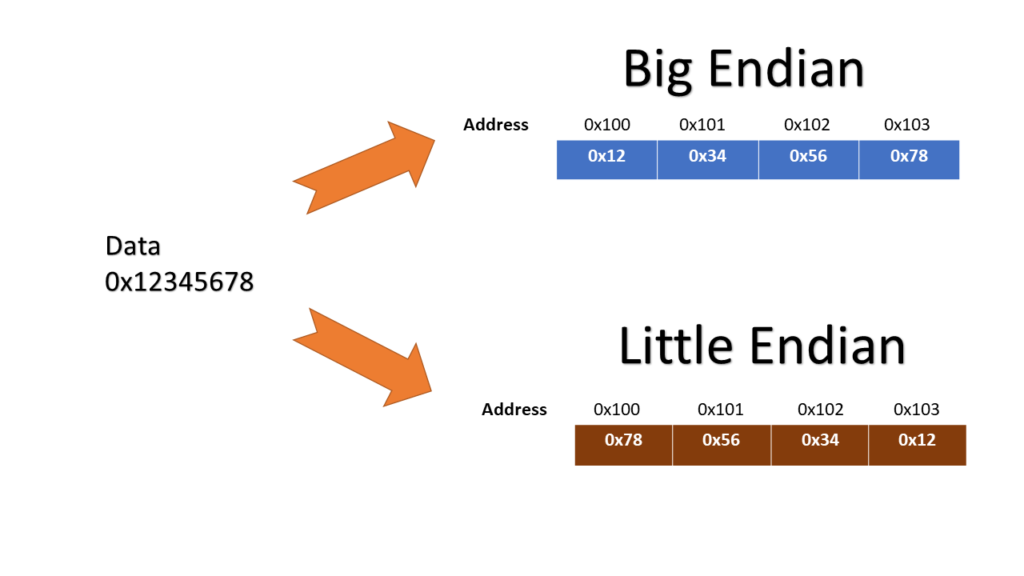Understanding Big Endian and Little Endian in Memory
When we talk about computer memory, we refer to it as a collection of bytes, each of which is assigned a unique address. In computing, the order in which these bytes are stored is called byte ordering, and there are two different ways to do it: big-endian and little-endian.

What is Big Endian Byte Order?
In big-endian byte order, the most significant byte (MSB) is stored at the smallest address, while the least significant byte (LSB) is stored at the largest address. This means that the byte ordering is from left to right, with the most significant byte first.
To understand this better, let’s take an example. Let’s say we have a 32-bit integer with the value 0x12345678. In big-endian byte order, the byte order would be as follows:
0x12 0x34 0x56 0x78
The MSB (0x12) is stored at the smallest address (the lowest memory location), while the LSB (0x78) is stored at the largest address (the highest memory location).
What is Little Endian Byte Order?
In contrast, little endian byte order stores the LSB at the smallest address and the MSB at the largest address. This means that the byte ordering is from right to left, with the least significant byte first.
Using the same example as before, if we store the 32-bit integer in little-endian byte order, the byte order would be as follows:
0x78 0x56 0x34 0x12
In this case, the LSB (0x78) is stored at the smallest address (the lowest memory location), while the MSB (0x12) is stored at the largest address (the highest memory location).
Why Does Byte Order Matter?
The choice of byte ordering can affect the way data is interpreted by a computer system. For example, if data is transmitted between two computer systems with different byte ordering, the receiving system may interpret the data incorrectly.
In addition, byte ordering can affect the performance of certain operations, such as bitwise operations and arithmetic operations. Some processors are designed to work more efficiently with a specific byte ordering.
Additional Details
Big-endian and little-endian byte order can be thought of as a way of representing numbers. In big-endian, we write numbers from left to right, with the most significant digit first. For example, the number 1234 is written as “12” followed by “34”. In little endian, we write numbers from right to left, with the least significant digit first. So, the number 1234 would be written as “34” followed by “12”.
When we store a number in memory, we break it down into its individual bytes and store each byte in a separate memory location. The choice of byte ordering determines the order in which these bytes are stored.
In addition to integers, byte order also applies to other types of data, such as floating-point numbers and character strings. In general, any data type that can be represented as a sequence of bytes can be affected by byte ordering.
Examples
Let’s look at some additional examples to better understand byte ordering.
Example 1: Converting from Big Endian to Little Endian
Suppose we have a 16-bit integer with the value 0xABCD, stored in big-endian byte order as follows:
0xAB 0xCD
To convert this to little-endian byte order, we simply swap the two bytes:
0xCD 0xAB
The value of the integer remains the same, but the order in which the bytes are stored has changed.
Example 2: Arithmetic Operations
Suppose we want to add two 32-bit integers, stored in different byte orders. The first integer is 0x12345678, stored in big-endian byte order, and the second integer is 0x87654321, stored in little-endian byte order.
To perform the addition, we first need to convert one of the integers to the other byte order. Let’s convert the second integer to big-endian byte order:
0x21 0x43 0x65 0x87
Now we can perform the addition:
0x12345678
+ 0x21436587
-----------
0x3377BCFF
Finally, we convert the result back to little-endian byte order:
0xFF 0xBC 0x77 0x33
The result is the same as if we had performed the addition on two integers with the same byte order.
Conclusion
Byte ordering is an important concept in computer systems, particularly for low-level programming and network communication. Big-endian and little-endian byte order represent two different ways of storing bytes in memory, and the choice of byte ordering can affect the interpretation of data and the performance of certain operations. Understanding byte ordering is an essential skill for anyone working with computer systems.
Read my other blogs:
C Program to find Given Number is Prime or not.
Write a program to find Factorial Numbers of a given numbers.
Embedded C language Interview Questions.
Automotive Interview Questions
Understanding AUTOSAR Architecture: A Guide to Automotive Software Integration
Big Endian and Little Endian in Memory
Zero to Hero in C language Playlist
Embedded C Interview Questions
Subscribe my channel on Youtube: Yogin Savani
